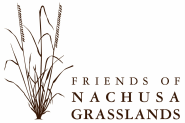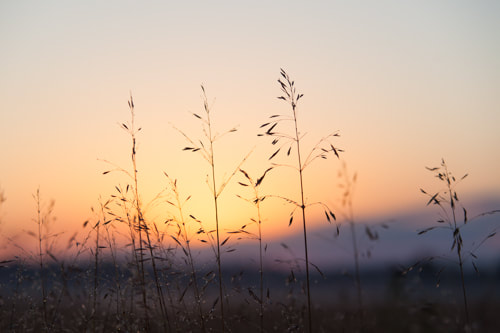Grass Family (Poaceae) |
Honeysuckle Family (Caprifoliaceae) |
big bluestemAndropogon gerardii
Rainbow colors Big Bluestem was so common here in the “Prairie State” that it was named Illinois’ state grass. Once it gets growing in mid-summer it sends up rainbow-colored flower stalks (yes, grasses have flowers, just tiny). The stem blends green into blue, purple, and red towards each joint (where the leaves are attached). Clump-forming native grass This grass like many of our prairie grasses grows in clumps rather than singly in mats. This leaves room for flowers and for ground-nesting birds to run about nearly unseen to and from their nests. Scientific name origins The scientific name is Greek for “man beard” (andro = man, pogon = beard), due to the hairs on the spikelets (flower parts). The species specific is to honor French botanist Louis Gerard who first described it. Indian grassSorghastrum nutans
One of the ‘Four Horsemen of the Prairie’ In historical times big bluestem, little bluestem, switch grass and Indian grass were the four dominant grasses in Illinois prairies — called the Four Horsemen of the Prairie. A native grass than can take the heat Indian grass begins to actively grow during the heat of the summer months. It is known as one of the ‘warm season’ grasses on the prairie, one that requires minimal water or fertilizer to thrive. The grass has long roots that can reach down deep for moisture during drought times. The roots are also known to stabilize the soil and therefore prevent erosion. Showy and tasty Different from lawn grass, Indian grass grows in elegant blue-green clumps in early spring and summer. Later in summer the stems shoot upward and are topped by a very showy cluster of flowers (a panicle). In fall the grass turns a beautiful orange-yellow and then remains interesting-looking throughout the winter. The grass provides great nesting cover for birds and nutritious forage for Nachusa’s bison, deer and other mammals, being full of protein and vitamin A. Scientific name origins Sorghum, which comes from the spoken Latin “suricum granum” means “grain from Syria”, while the Latin suffix “astrum” means an incomplete resemblance; nutans is Latin for nodding and refers to the appearance of the flowering heads. little bluestemSchizachyrium scoparium
Little bluestem is the most common grass in Nachusa Grasslands’ dry remnants. It is only bluish when it first starts growing in early summer. By the time we notice this clumping grass it is a mix of tan, brown and wine-red and in autumn turns a lovely burnt orange. The dried flowers are a fluffy silvery white and when the wind blows in autumn the waves of grass are reminiscent of the ocean. Scientific name origins The genus name is Greek for “split-chaff” named for the bracts of the flower; one is fuzzy and one is smooth in little bluestem. The species name (Latin) refers to looking like a broom. An old common name for this is broom beardgrass. porcupine grassHesperostipa spartea
Do the twist! This is a favorite grass because the awn of the seed is so interesting. Grasses have many parts to the structures that form around the flowers and later the seeds. Often there are long bristle-like appendages called awns. The awn in porcupine grass is very long (3-8 inches) and has a grooved, dark-colored side and a light-colored side. The difference in heating and drying on the dark vs light side of the awn causes the awn to twist and bend. Ideally when this seed falls off, the twisting action (called geocarpy), drills the seed into the soil. But it will also get into animal fur or your socks because the end is so barbed! Laura Ingalls Wilder writes about this grass in one of her books because the barbs were irksome getting caught up in the girls’ petticoats. Some Native Americans used the awns tied together as brushes (after burning off the sharp tips). Scientific name origins The first part of the scientific name, hespero, means western or evening and the second part, stipa, means fiber. The specific name, spartea, means broom-like or used for a broom (some thorny shrubs were used to make brooms). switch grassPanicum virgatum
A tallgrass Switch grass, along with big bluestem, Indian grass, and little bluestem are the main bunch grasses forming the tallgrass prairie. Tallgrass and Mixed Grass Prairie is almost extinct as a functioning ecosystem. Only tiny original patches of tallgrass remain in Illinois; less than one tenth of one percent! That is why we try to replant prairie in old farm fields to expand the habitat for the 245 bird species and over 250 bee species and many other critters that live at Nachusa Grasslands. By the way, livestock (and bison) love to eat the tallgrasses. In the Flint Hills of Kansas ranchers still regularly burn their prairie pastures for their cattle. Scientific name origins Panicum is Latin for millet which is also in this same genus and virgatum means “wand-like”. |
late horse gentianTriosteum perfoliatum
This plant sign is under construction. Check back next time. |

